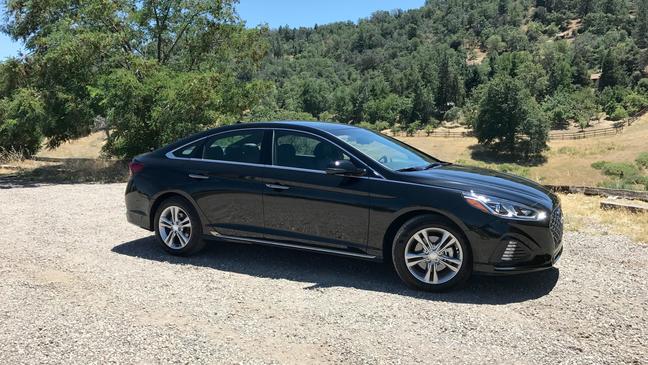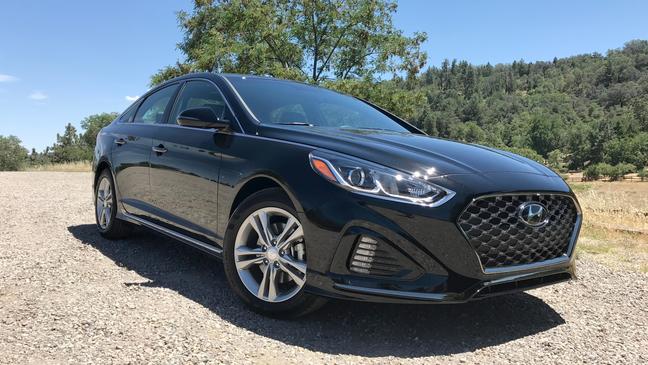2018 Hyundai Sonata: Refreshed Sonata focuses on design [First Look]
TOPICS:
honda accordThe sedan isn’t dead.
Toyota just launched its all-new 2018 Camry. Honda has an all-new 2018 Accord in the queue, and Hyundai just released a significant refresh for its seventh generation Sonata.
“There’s still a lot of market potential for sedans,” said Mike O’Brien, vice president of product, corporate and digital planning for Hyundai Motor America. “It’s just not quite as large as it was in 2012.”
Sedans were king and held 16.1 percent of the industry share in 2012, selling 2.3 million units. In 2016, sedans dropped to No. 4 behind large pickups, compact SUVs and compact cars, holding just 10.8 percent of the industry share and selling 1.8 million units.
Hyundai is banking on the forecast that industry share for sedans will level off.
The good news is with fewer sedans being sold, those automakers selling cars of the four-door variety will need to make them pretty great.
And, after checking out two of the three aforementioned models debuting in 2018, I have to say competition is a good thing.
It compelled Hyundai to refresh the Sonata after just 3 years on the market. And we’re talking about significant design changes. The basic profile of the Sonata stays the same, but the front – from the side mirrors forward – and the back – from rear wheel wells backward – are radically redesigned.
The folks at Hyundai were quick to acknowledge that they put out an attractive car for the seventh generation, but it just wasn’t quite as remarkable as the game-changing 2011 model. “Conservative” was one of the words they used to describe it.
“The 2015 model is handsome; it’s a good car,” said Edward Lee, design manager for the Hyundai Design Center. “What we want to do is create something great.”
In addition to LED lighting the front and rear fascia get more sculpted, and the grille becomes more prominent. It comes off being both elegant and aggressive – and it’s certainly more attractive.
But I’m not quite sure they hit the same note as they did in 2011.
The interior gets a refresh with an updated center stack, steering wheel and behind-the-wheel gauge cluster. Apple CarPlay and Android Auto are now standard, and wireless charging and a rear USB port are also available.
The 2018 Sonata has several other new features including a hidden trunk release button, intelligent LED headlights, lane keep assist with driver attention alert and standard blind spot monitoring with rear cross-traffic alert.
We thought it was interesting that Hyundai included blind spot monitoring with rear cross-traffic alert as standard but made automatic emergency braking (AEB) an option starting at the SEL trim. Toyota employed the opposite strategy with the new Camry, making AEB standard and blind spot monitoring optional.
The reasoning: As Hyundai pointed out during the press preview, 1 percent of your drive time is spent in reverse, but a quarter of all accidents happen in reverse.
So, the Sonata will help prevent those accidents, but it won’t qualify for an IIHS Top Safety Pick + Award without optional features.
The 2018 Sonata has two engine options at launch: a 2.4-liter, 4-cylinder that delivers 185 horsepower and a 2.0-liter turbocharged, 4-cylinder that delivers 245 horsepower.
The 2.4-liter is available on the SE, SEL, Sport and Limited models, and the 2.0-liter is available on the Sport and Limited models.
I had the chance to drive vehicles with both engines during the press preview, and the 2.4-liter was plenty powerful for passing and aggressive maneuvers, whereas the 2.0-liter was just plain fun.
A part of the refresh includes a firmer rear suspension, which translates into stiffer ride and better handling. I enjoyed the Sonata’s on-road manners, and Hyundai did a good job making the seats more comfortable and the cabin very quiet.
The trim lineup for the 2018 doesn’t change much, and the pricing actually gets more competitive with some of the pricier trims costing less with more content. Even the base SE trim only costs $100 more than the 2017 model and adds more standard content. The pricing breakdown is as follows:
- SE 2.4: $22,050
- ECO 1.6T: $22,650
- SEL 2.4: $23,700
- SEL Tech 2.4: 24,700
- Sport 2.4: $25,200
- Limited 2.4: $27,400
- Limited Ultimate 2.4: $30,300
- Sport 2.0T: $27,600
- Limited 2.0T: $32,450
So, the engine above that I didn’t mention is the1.6-liter turbocharged, which will be available in the ECO models. It wasn’t available at the press preview, but it should show up in dealers later this summer. It will deliver 178 horsepower and will get an estimated 31 mpg in combined driving (as opposed to 28 and 26 mpg for the 2.4 and 2.0T engines, respectively).
Coming in early 2018, you will also see plug-in and hybrid versions of the refreshed Sonata. Stay tuned for more details there.
The bottom line is that the Sonata is a really nice vehicle. It’s attractive, it drives well, and it’s comfortable. But, I think that Toyota outmaneuvered Hyundai in the design department. I would consider the new Camry to be cutting edge -- a refreshing change from the boring humdrum design of yore. And the Sonata is simply a nice change.
Camry manages to come off being a bit sportier, and the Sonata is more sedate.
Don’t get me wrong: If you like Hyundai, you’ll love the refreshed Sonata – it is a great vehicle. I’m just not sure the change is enough to bring new people into the brand. Then again, beauty is in the eye of the beholder.
Editor’s Note: Driving impressions in this “First Look” review are from an invitation-only automaker launch event that allowed special access to the vehicle and executives. Hyundai covered our accommodations, meals and transportation costs.



